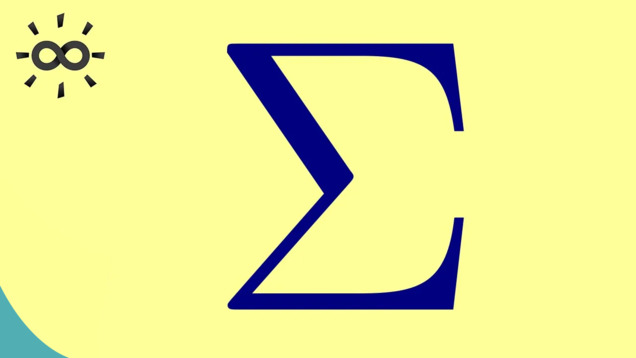
-
Title: Sum Symbol
-
Series: Advent of Mathematical Symbols
-
YouTube-Title: Advent of Mathematical Symbols - Part 7 - Sum Symbol
-
Bright video: https://youtu.be/S5DdXfxl3ac
-
Dark video: https://youtu.be/6saSeZ3W2q0
-
Quiz: Test your knowledge
-
Dark-PDF: Download PDF version of the dark video
-
Print-PDF: Download printable PDF version
-
Thumbnail (bright): Download PNG
-
Thumbnail (dark): Download PNG
-
Subtitle on GitHub: aoms07_sub_eng.srt
-
Timestamps (n/a)
-
Subtitle in English
1 00:00:00,543 –> 00:00:03,714 The mathematical symbol of today is the sum symbol.
2 00:00:03,843 –> 00:00:05,722 Written as a capital Sigma.
3 00:00:06,557 –> 00:00:10,471 and below the Sigma, usually you find the name for an index.
4 00:00:10,472 –> 00:00:12,400 So fo example it could be “k”.
5 00:00:13,300 –> 00:00:19,430 and if you see k = 1, this means 1 is the starting value for the variable “k”.
6 00:00:19,843 –> 00:00:24,778 On the other hand, on the top of Sigma you find the n-th value for the variable “k”.
7 00:00:25,557 –> 00:00:30,657 This means if this is the sum of the numbers “a_k”. Then we get
8 00:00:31,414 –> 00:00:39,300 “a_1” + “a_2” + “a_3” + and so on. Until we reach “a_n”.
9 00:00:40,629 –> 00:00:43,821 This means that we start with the index given here
10 00:00:44,021 –> 00:00:45,425 Then we increase it by 1.
11 00:00:45,625 –> 00:00:46,493 Do the addition.
12 00:00:46,571 –> 00:00:52,577 Then we increase it by 1 again. Do the addition again. Until we reach the value for the index given here.
13 00:00:53,057 –> 00:00:57,081 So this whole thing here should explain what the sum symbol means.
14 00:00:57,657 –> 00:01:02,568 However in a formal way, you can also write down a recursive definition for this symbol.
15 00:01:03,414 –> 00:01:09,249 More concretely this means, first i tell you what happens when “n” here is equal to 0.
16 00:01:10,014 –> 00:01:17,516 Then the whole thing from above wouldn’t make any sense, because by just increasing the index by 1 we would never reach 0 here.
17 00:01:18,214 –> 00:01:24,029 However in this case we define it as the empty sum. Which means it should be 0.
18 00:01:25,071 –> 00:01:29,438 In other words if we don’t sum anything we stay at the value 0.
19 00:01:30,286 –> 00:01:36,114 and then in the second step for recursive definition, we need to know what happens to the successor.
20 00:01:36,649 –> 00:01:42,013 Or more precisely the successor n is defined by the predecessor n-1.
21 00:01:42,957 –> 00:01:52,515 Indeed this is not hard to understand. If we have this sum from k = 1 to (n - 1), we just have to add the last term to get this sum.
22 00:01:53,343 –> 00:01:57,019 and then you see this is our recursive definition for the sum symbol.
23 00:01:58,071 –> 00:02:04,105 and with this you shouldn’t have any problems generalising this to other starter indices here.
24 00:02:04,657 –> 00:02:08,499 Ok, so i hope i see you in the next video. Bye!
-
Quiz Content
Q1: Let $a_1 = 2$, $a_2 = 1$, $a_3 = 0$, $a_4 = -1$. What is correct?
A1: $$\sum_{j=1}^4 a_j = 2$$
A2: $$\sum_{j=1}^4 a_j = -2$$
A3: $$\sum_{j=1}^3 a_j = 4$$
A4: $$\sum_{j=1}^2 a_j = 1$$
Q2: The sum symbol also makes sense for infinite index sets if only finitely many entries are non-zero. For example, one writes $$\sum_{x \in \mathbb{R}} a_x$$ for the finite sum in the case that $a_x \neq 0$ only for finitely many numbers. With this in mind, what is a correct usage of the sum symbol?
A1: $$\sum_{x \in \mathbb{R}} 0 = 0$$
A2: $$\sum_{x \in \mathbb{R}} 1 = 1$$
A3: $$\sum_{x \in \mathbb{R}} x = 1$$
A4: $$\sum_{x \in \mathbb{R}} \frac{1}{x} = 1$$
Q3: Calculate the sum $$ \sum_{i=3}^5 (2^i -1) ,.$$
A1: 53
A2: 7
A3: 15
A4: 101